Due to a spike in COVID-19 cases at the Rose Hill campus (more than 110 cases in the last two-week window), we are pausing in-person instruction and activities on that campus for two weeks to reduce the infection rate, as required by New York state, effective Sunday, February 14, 2021.
The following restrictions are effective immediately and apply to Rose Hill only:
- All classroom instruction will switch to remote instruction (students who live on one campus and take classes on the other will also switch to remote instruction);
- All in-person student programming is suspended;
- Indoor dining is suspended;
- The Ram Fit Center and all indoor athletics facilities are closed;
- All athletics practices and competitions are suspended;
- Ram Van service is suspended between Rose Hill and other campuses.
Not affected:
- Residence halls will remain open;
- Students are not required to return home;
- Students are not restricted from leaving their residence halls nor off-campus residences;
- Outdoor walking, exercise, and other socially distanced activity is permitted;
- Walsh Library and the campus center will remain open with strictly enforced mask usage and social distancing.
University staff at Rose Hill should take direction from their managers regarding whether or not to report to work in person.
All activities on the Lincoln Center campus will continue without any new restrictions nor additional precautionary measures. During the next two weeks, members of the Lincoln Center campus community should not visit those on the Rose Hill campus and vice versa.
We take these measures reluctantly, but we believe pausing activities at Rose Hill offers us our best chance to reduce the spread of COVID-19, and to resume a more normal campus routine for the rest of the spring semester. For your health and safety, and that of the campus community, I ask that you faithfully observe COVID-19 precautions at all times, on and off campus:
- Wear masks correctly (snugly covering nose and mouth) at all times in public spaces;
- Observe social distancing of at least six feet;
- Avoid crowded indoor spaces, even if you are wearing a mask.
I understand this is another unwelcome development in a long and difficult year, but your wholehearted cooperation and observance of appropriate precautions is critically important in ensuring that we limit the spread of the virus and give our students the best opportunity for a positive on-campus experience for the remainder of the spring semester.
I know you can do this, given the good judgment and care for one another you displayed in the fall. Though we are not out of the woods yet, we can see the path forward. Please help us not to stray in these next few months.
Please know that you are all in my prayers today and every day.
Joseph M. McShane, S.J.
]]>St. Ignatius said his schools should be “for everybody, poor and rich.” Unfortunately, our need is always greater than our resources—scholarship endowment covers less than 7 percent of Fordham’s scholarship budget. Giving to this campaign helps ensure that deserving students who might otherwise not afford a Fordham education can receive one.
Though the University is closed for the Christmas and New Year’s holiday break, development staff will be in the office on Tuesday, December 29, Wednesday, December 30, from 10 a.m. to 3:30 p.m.; and on Thursday, December 31, from 10 a.m. to 5 p.m.
You may make a gift online prior to midnight on December 31, to ensure that your gift is tax deductible for the 2015 calendar year. For assistance with making a gift to the University, contact the Office of Development at: (212) 636-6550 or [email protected].
This week President Obama signed a bill making permanent a 2014 law that allows people age 70.5 years and older to transfer up to $100,000 from their IRA account to Fordham and other qualified public charities. Such transfers will not be considered taxable income. For more information, please see Planned Giving on the web, or contact Jackie Comesanas, senior director of gift planning, at: (212) 636-7244 or [email protected].
For more information about giving, go to Ways to Give.
It is our sincere hope that the coming year will be one of love, fulfillment, prosperity, and joy for you and your families.
]]> Angela Alaimo O’Donnell hadn’t planned to write a book about the last 48 days of her mother’s life.
Angela Alaimo O’Donnell hadn’t planned to write a book about the last 48 days of her mother’s life.
O’Donnell, associate director of the Curran Center for American Catholic Studies and a member of the English & American Catholic Studies faculty, had already turned to poetry—her field of expertise—with Waking My Mother (WordPress, 2013).
But after a 2010 essay that she wrote for Commonweal Magazine received positive feedback, she decided to revisit the topic. The result, Mortal Blessings: A Sacramental Farewell (Ave Maria Press, 2014), is equal parts memoir and meditation about the short but intense time when her mother Marion suffered a fall and died 48 days later.
As O’Donnell and her sisters tended to her mother in the hospital, she began to see connections between the rituals that they practiced every day and the sacraments of her Catholic faith. Going through the motions of helping her mother ride around the hospital in her wheelchair, or feeding her a piece of pie, helped ease the trauma, she said, even if the rituals were unspoken at the time.
“I thought I’d meditate on the nature of sacrament, and the ways in which human beings, whether they’re Catholic or not, devise rituals to get us through difficult situations,” she said.
“I’d read a lot about sacramentality, and thought I could incorporate all of these elements theoretically. But I realized as I was writing it that unless it was tied to something concrete, readers were not going to be very interested in something abstract and theoretical. Who cares about a book like that when you’re talking about the experience of watching someone die?”
In addition to the Catholic Churches’ seven sacraments, O’Donnell added additional ones, such as the “sacrament of the cell phone.” She also sought and received permission from her sisters to reveal details that would not have otherwise been revealed through poetry. Details like the fact that, her mother was not a, shall we say, an easy-going sort.
“We didn’t see eye-to-eye with her on anything,” she said.
“I felt privileged to be back there in these circumstances, where really there was an unspoken forgiveness of all the years of neglect, and the years of being at odds with each other just sort of disappeared.”
The chapter that she would call “the sacrament of the beauty” was the breakthrough chapter for her. O’Donnell’s mother was devoted to beauty in her own way, and she said she and her sisters did all they could to help her by decorating her hospital room.
“Saint Augustine was always in my ear at that point—‘Late have I loved you, beauty so old and so new; late have I loved you,’” O’Donnell said.
Caring for someone who cared for her when she was a child also made O’Donnell realize that the tables could very well be turned later in life. And although her normal response would be to not make herself too much of a burden, she said her mother’s “spunk” made her rethink this attitude.
“One of her favorite expressions was, ‘I’m the important person here.’ That used to drive us crazy. But when she was sick and really needed help, I kind of admired that she just demanded to get attention. She wasn’t just going to lie there and be neglected,” she said.
“She was terribly diminished by what was happening to her [but]her spirit wasn’t diminished. I admired that in her, and I hope we all have a little bit of that undiminished spirit in us.”
]]>While there, he wondered why so many houses still needed work almost eight years after suffering damage from Hurricane Katrina.
“When I talked to the homeowners, they’d say ‘I hired a contractor, and they took the money and took off,’” he said.
Many of these homeowners had won judgments against contractors in court. But DeCoster discovered that just because you win a case in small claims court doesn’t mean you necessarily get your money back. Claimants often turn to collection agencies to track down money, but many agencies won’t bother with judgments of less than $1,500. And even when they do, they often take a cut as high as 50 percent.
Consequently, DeCoster said 80 percent of judgments go uncollected, even though they might represent a poor person’s life savings.
Enter Judgment Pay. As part of the Law Without Walls (LWOW) program, DeCoster and two fellow students came up with a business plan that seeks to use technology to “bring judgment collections into the 21st century.”
LWOW is an international collaboration that teams up students from 30 law and business schools with academic, lawyer, and entrepreneur mentors that Fordham joined five years ago as a founding member.
Judgment Pay, a website that is under development, will capitalize on the importance of a business owner’s reputation. If contractors have any outstanding judgments against them, their name will be entered into a public database. Potential customers will be able to search the database and will likely be discouraged from working with such contractors.
Although the aim of the site is altruistic—getting money back to those people who’ve lost it—DeCoster said the site is designed so that everyone involved can benefit monetarily. Those looking to collect judgments can benefit by getting their money back; those who owe customers money can benefit from clearing their reputation; and tipsters who may know how to track down and help get a crooked contractor listed on the site will be entitled to a small cut of the collected judgment.
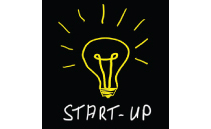 The emphasis on building in incentives for all involved made an impression on the LWOW judges; Eric Satz, managing director of Tennessee Community Ventures Fund, told the team “in the four years of LawWithoutWalls, this is the most fundable idea that we have seen yet.”
The emphasis on building in incentives for all involved made an impression on the LWOW judges; Eric Satz, managing director of Tennessee Community Ventures Fund, told the team “in the four years of LawWithoutWalls, this is the most fundable idea that we have seen yet.”
LWOW at Fordham Law came about through the efforts of Bruce Green, the Louis Stein Chair of Law and director of the Louis Stein Center for Law and Ethics. Green knew Michelle DeStefano, a professor at Miami law School, from ethics-related conferences, who initiated the idea and invited Fordham Law to join the initial group of schools.
Green said he was attracted to the collaborative’s emphasis on teamwork and exploiting new Internet technology. Traditionally law students look to join an established private law firm, government law office, or legal services office. Unlike business school students, they rarely strike out on their own.
But that has to change, Green said.
“The world is becoming global, and there’s a lot of exponential change in the legal profession,” he said.
“Nobody wants to stop training students in the traditional skills, such as legal analysis and communication. We want go beyond those, however, and to think about emotional intelligence, leadership, entrepreneurship, and teamwork.”
This isn’t to say that Fordham Law hasn’t turned out its fair share of successful entrepreneurs.
A short list of alumni would include Mukesh Patel, LAW, 94, who founded JuiceTank, New Jersey’s largest co-working space and startup incubator; Daniel Gross, LAW ‘07, who founded Brandworkers International, a non-profit organization protecting and advancing the rights of retail and food employees; and Zaid Hydari, LAW, ’09, co-founded Refugee Solidarity Network.
It would also feature Andrew Cabasso, LAW ‘12, co-founder, JurisPage, a New York based law firm Internet marketing company that helps law firms around the country to market themselves online, and Robert Sanchez, LAW, 14, Chief Strategy Officer for Manufacture New York.
Sonia Katyal, associate dean for research and the Joseph M. McLaughlin Professor of Law, said there are employment opportunities for lawyers particularly in the fields of intellectual property, employment law, and corporate law.
The Law School, in fact, has several initiatives devoted to entrepreneurship—from the recently founded Student Association for Law and Entrepreneurship (SALE) to an entrepreneurial law practicum that will be offered this spring.
“This exists partly because of the changing job market for our law graduates, but part of it is also the rise of New York City as a central innovation hub for tech firms,” she said.
“There’s a lot of information circulating about “Silicon Alley,” and the time is really right for getting our students into the tech start up market.”
Katyal and law professor Ron Lazebnik co-chair a university-wide entrepreneur’s working group that meets periodically. She said the law school has also collaborated with the Gabelli School of Business. It’s all part of a move away from the model of the lawyer as adviser.
“Lawyers are far more entrepreneurial than they’ve ever been in terms of how to develop new clients and embrace new ideas. Lots of people I went to law school with went on to join valuable companies first as lawyers and then in other roles within the companies,” she said.
As for Judgment Pay, DeCoster recently teamed up with Uriel Carni, LAW ’14. They’re still courting investors, but he’s hopeful that the site will launch shortly.
“Every step of the way, someone is motivated to help and get involved. So I think that’s probably one of the reasons why this project won, and why there’s a lot of buzz about it as a potential business idea,” he said.
]]>
Loyola, a former Jesuit residence, was converted into a 121-bed freshman residence hall over the last two years, affording all its incoming students comfortable accommodations, but the three roommates got a little something extra: room 415, the old quarters of Fordham’s president, Joseph M. McShane, S.J.

“I feel really lucky, when I first found out (on move-in day) that it was Father McShane’s old room,” Abigail Kedik said. “I was so excited, I almost took it as a sign that Despite the nerves I chose the right school.”
Kedik attended Guilderland High School in her home town of Altamont, N.Y. She plans to major in Political Science/International Studies with a minor in History or English. “I absolutely love living in Loyola. Besides the fact that the building is historic and gorgeous, the Manresa community is wonderful,” she said.
Father McShane lived in room 415 from 1992 to 1996, when he was dean of Fordham College at Rose Hill (he lived in Spellman Hall for the last two years of his tenure as dean, after the Jesuit community active in the University moved to Spellman). Father McShane extolled the room’s virtues when he met its new occupants at Move In this fall.

“The commute could not be beat! I just had to run down the stairs right outside my room and could be in my office in about five minutes,” Father McShane said. “One oddity of the room: I was awakened every morning at around 5 when the steam heat started up and the pipes banged to beat the band.”
“When I first saw how gorgeous Loyola is and the spacious room I would be living in, I was so grateful,” Leyla Maloney said. “I realized how lucky I was just to be in a newly renovated building, living with a close knit community, with Father Phil and the other RA’s and RD Alex, and most of all being a Manresa Scholar.”
Maloney is a cello player from Westchester, N.Y., and attended Somers High School in Lincolndale. She said Fordham exceeded her expectations. “My roommates are my two closest friends, my entire residence hall is a close-knit community, and my Professors are really devoted to their profession and their students.”
Sarah Kimball is from Simsbury, Conn., and attended Simsbury High School. She said she has already seen I’ve already seen eight plays and musicals since coming to New York, and has been to many different parts of the city so far.
“I am so thankful to everyone who has helped me get here,” Kimball said. “Being in room 415 is particularly special to us because it was Father McShane’s room… Living in Loyola Hall is absolutely wonderful and I will be so sad when I have to move out at the end of the year!”

Jesuits called Loyola Hall home from 1928 to 2012, when the University purchased the building from the Society of Jesus, as it was making a transition to smaller Jesuit communities. In addition to students, the refurbished Loyola houses the residential life office, social and study lounges, a chapel, two Integrated Learning Community classrooms, and a community laundry facility.
“Father McShane said that Fordham is doing its job wrong if we are the same people at graduation day that we were on the first day of school,” Kimball said. “Thanks to Fordham, I have already noticed myself changing into the person I want to become.”
]]>When you go to your doctor’s office for the test, everything comes back normal. But lurking somewhere inside, there is, in fact, an abnormality—it just did not occur during your office visit.
“You’re out of luck,” said Gary Weiss, Ph.D., an associate professor of computer and information sciences.
However, Weiss said, if the capability to monitor your heart were built into your smartphone, “you could be monitored over a longer period of time, as opposed to just a few minutes, which provides a lot more data.”
Mobile health and smart technology
With the advent of smart technology, that capability has become a reality. Originally designed to give doctors access to patients in remote, rural areas of developing countries, mobile health platforms have since proliferated. In just seven years, these devices have grown increasingly more complex. They can now accomplish tasks as simple as counting the number of steps you take and as sophisticated as checking glucose levels in your blood.

Weiss, who is the director of Fordham’s Wireless Sensor Data Mining (WISDM) Lab, has been making a foray into the field of mobile health by applying his research on activity-recognition to the newest member of the “smart” family, “smartwatches.” The WISDM lab’s latest work builds on the Actitracker, an application (“app”) for Android-based cell phones that the lab launched in 2013.
Using a built-in sensor called an accelerometer, the app detects and identifies the user’s physical activities, such as sitting, walking, jogging, standing, or climbing stairs. It then compiles the results so that the user knows how many minutes per day are spent sitting, standing, etc. When the app “learns” the nuances of its user’s movements using a built-in “self-training mode,” it yields results that are up to 98 percent accurate.
“The project was funded because of its potential to help combat obesity,” said Weiss, who received a National Science Foundation “Smart and Connected Health” grant for the project. “But it can really help with a lot of issues. For instance, tracking how someone walks could detect if they have any gait problems. Or we might be able to track depression if someone is spending the majority of the time lying down.”
Integrating Actitracker with smartwatches will make the app even more sophisticated, Weiss said, because it will be able to detect activities such as eating or drinking.
“A smartphone in your pocket is limited, because it really can only detect your leg motions, specifically the top of the legs. The smartwatch, though, will also be able to detect hand motions to identify activities like eating and drinking,” Weiss said.
For those who need to monitor their diets, having an app that can call attention to food intake can be invaluable. For instance, Weiss said, when the watch detects that you are eating, it could prompt you to add an entry to your food diary. Or, when it detects that you are drinking something, it might ask about the sugar content of your drink and advise accordingly.
Smartwatches arrive at the WISDM Lab
Sophomore Andrew Johnston is one of the students working on smartwatches in the WISDM lab.
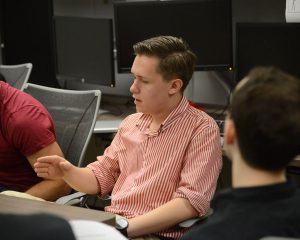
“The accelerometer and gyroscope give feedback in terms of the number of steps you’re taking and there’s also a heartbeat sensor to take your pulse throughout the day,” said Johnston, a computer science and mathematics major.
“No one is doing activity-recognition with smartwatches right now, so we’re looking to corner the market there.”
Johnston is also doing research in biometrics, the study of distinctive, measureable human traits such as fingerprints or DNA. Johnston’s research focuses on using biometric markers for identity and security purposes—in other words, using things like voice or gait recognition in lieu of passwords.
“The problem with passwords is that they’re really weak,” Johnston said. “People who come up with them design them to be memorable. Which means that most of the time they’re also guessable.”
The process involves just a few steps, Johnston said. For instance, if you wanted to program a smartwatch to open a locked door using gait recognition, you would first demonstrate to the watch how you walk. Then the watch and the door would be programmed to associate your particular gait with the action “unlock door.” Thus, when you approach the door, the watch and door compare your walk with the profile on file, and if they match, the door unlocks.
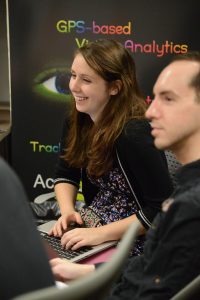
“Moving to biometrics would make it more difficult for someone to get unauthorized access, because it’s a lot harder to guess how I walk than to guess something I use as my password,” Johnston said, adding that biometrics could ultimately be used for social media profiles and even electronic bank accounts.
Currently, the team is conducting experiments with the smartwatch and plans to have it integrated into the Actitracker app within six months. In the meantime, Weiss has submitted another grant proposal to the National Science Foundation to continue expanding their work with activity recognition—including integrating the app with social media so that users can broadcast their results.
“There are companies interested in this type of technology. Some startups have contacted us,” Weiss said. “All of this is now becoming technologically feasible because of the ubiquity of these powerful devices.”
]]>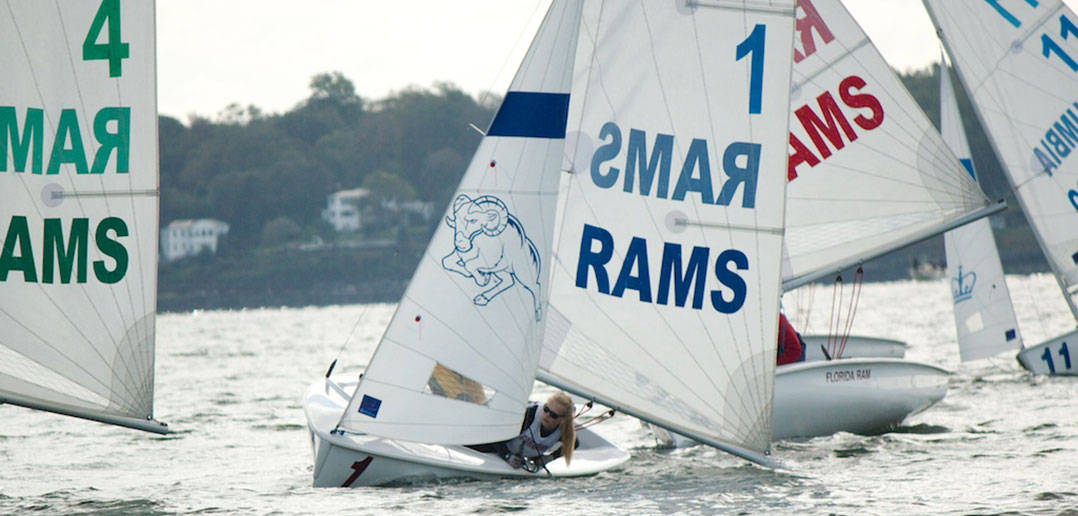 Just as the football team was taking the Patriot League Title and the women’s basketball is gearing up for what is sure to be yet another winning season, the Fordham Rams Sailing Team was ranked among the top 10 in a coaches’ poll taken by Sailing World Magazine.
Just as the football team was taking the Patriot League Title and the women’s basketball is gearing up for what is sure to be yet another winning season, the Fordham Rams Sailing Team was ranked among the top 10 in a coaches’ poll taken by Sailing World Magazine.
With little of the fanfare rightfully accorded to the University’s varsity teams, Fordham Sailing is a club team that has quietly been improving since it was reintroduced to the University after a 27-year hiatus.
Breaking the Top 10 ranking of the Intercollegiate Sailing Association of North America (ICSA) is a first for the team. It’s No. 7 position of the ICSA’s 230 varsity and club coed teams is made all the sweeter in that it also makes Fordham the No. 1 ranking among the 194 club teams. In addition, the team bested several nautical colleges, including U.S. Naval Academy, SUNY Maritime, and the U.S. Coast Guard Academy.
Club director Joe Sullivan, FCRH ‘58, said that he and several other alumni had been scouring the country to recruit students with a sailing background. The results are a diverse group of men and women from around the country.
Sullivan said the team was founded in 1950, became varsity in 1955, and continued through 1971 before being dropped. In 1999 Sullivan and his fellow alumni went to then athletic director Frank McLaughlin with a proposal to start up the team again. With McLaughlin’s blessing the team signed 102 players, 29 of whom had sailing experience, and seven of whom would go on to build the beginnings of today’s winning team.
Today the club is a member of the Middle Atlantic Intercollegiate Sailing Association (MAISA), one of seven regional conferences of ICSA. The team operates out of the Morris Yacht Club on City Island.
For several years Sullivan pitched in with coaching, together with Head Coach Reed Johson, but happily ceded his position this past June to Head Coach Johnnny Norfleet after a three-person search committee helped snag Norfleet from the University of Pennsylvania. Johnson recruited most of the current roster that Norfleet took to the top ten.
“Johnny was the unanimous choice,” said Sullivan.
Sullivan said that from the standpoint of “men and women for others” the team has raised funds for the Children’s Tumor Foundation and pitched in with clean-up on City Island after Hurricane Sandy.
“The admissions office is happy because our kids come from all over the country, their geographical diversity is superb,” he said. “And they’re great students, I’ll bet we’ve got the highest GPA of any team on campus.”
Here’s how the rankings played out:
1. Yale
2. Georgetown
3. Boston College
4. Charleston
5. Tufts
6. Dartmouth
7. FORDHAM
8. Roger Williams
9. Harvard
10. Stanford
Here’s the article.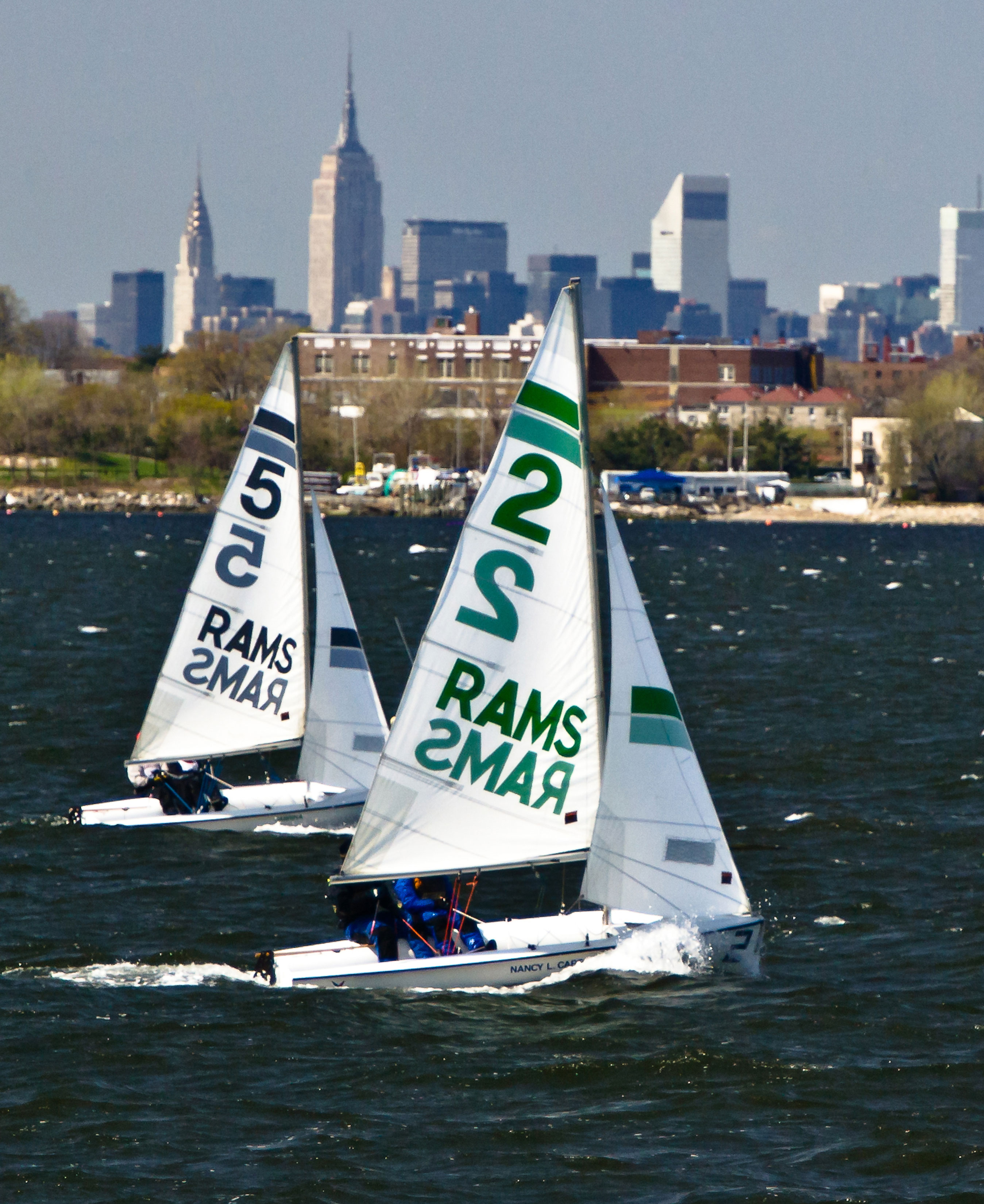
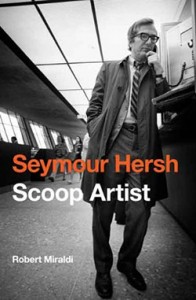 Fordham University has awarded Robert Miraldi’s book on investigative journalist Seymour Hersh the 2014 Ann M. Sperber Award.
Fordham University has awarded Robert Miraldi’s book on investigative journalist Seymour Hersh the 2014 Ann M. Sperber Award.
Miraldi will accept the honor at a ceremony at the Lincoln Center campus’ Corrigan Conference Center on Wed., Nov. 19 at 4 p.m., where he will give short talk on his book, Seymour Hersh: Scoop Artist (Potomac Books, 2013).
The Sperber prize, presented by the Department of Communication and Media Studies, is meant to encourage biographical works that focus on media professionals. It is given in honor of Ann M. Sperber, author of the biography of Edward R. Murrow, Murrow: His Life and Times, (Fordham University Press, 1999) and was established with a gift from Sperber’s mother, Lisette.
Miraldi, who holds a doctorate in American studies and a master’s in journalism, said that investigating one of America’s best investigative journalists required a combination of scholarly research and gumshoe reporting.
The 77-year-old Hersh’s career began in the early 1960s. Miraldi bookends the biography with Hersh’s Pulitzer Prize-winning 1969 free-lance coverage of the My Lai Massacre and his 2004 reporting for The New Yorker on the U.S. military’s mistreatment of prisoners at Abu Ghraib.
Miraldi, a professor of journalism at the State University of New York’s College at new Paltz, said the research took about eight years. He said he called the legendary journalist to inform him of his plans to write the biography, to which Hersh replied, “I’m not dead you know.”
Miraldi said that as a scholar he “dug” into Hersh’s work, which includes nine books, dozens of New Yorker articles written from 2000 to 2010, hundreds of articles for the New York Times written from 1972 to 1979, and a trove of articles that Miraldi uncovered from the Associated Press archives written between 1962 and 1967. He also examined memos, letters, CIA documents, and FBI files.
Miraldi also contacted hundreds of Hersh’s colleagues, including the late great Washington Post editor Ben Bradlee, who told Miraldi that not hiring Hersh “was a helluva’ mistake that I’ll regret for the rest of my life.”
“One is intimidated by investigating one of the greatest investigative journalists, so I’d say that I approached it more as a historian than as a reporter,” Miraldi said. He added that a historian would interview a source and ask “Do they have papers?” to back up a claim, whereas a reporter would ask “Do they have a telephone?”
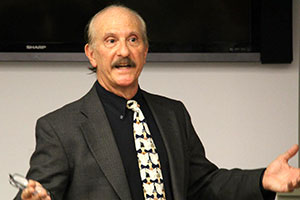
For his part Hersh was accommodating, if not fully accessible, since he’s at work on a book about former Vice President Dick Cheney. Miraldi said the journalist gave the project a “semi-blessing” and was helpful, but drew the line at access to his family. Nevertheless, the two exchanged plenty of emails and held several phone conversations.
Miraldi said that Hersh was part of movement in journalism that was fed up with “the rule of objectivity,” in light of the horrors of war. With journalism today in a state of profound flux, Miraldi said that he still holds out hope that new generations of journalists will carry on long-form investigative pieces that challenge authority.
“It begs the question as to whether will we see investigative journalism in an age of quick hits, but on the other hand the long form really can flourish in new media,” said Miraldi.
]]>
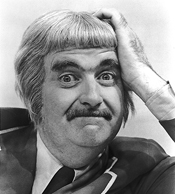
Courtesy of Michael Keeshan
On Oct. 22, Fordham welcomed four distinguished alumni as the newest inductees into the University’s Hall of Honor.
The Rev. Vincent R. Capodanno, Servant of God; Bob Keeshan, a.k.a. Captain Kangaroo; U.S. Army staff sergeant Robert C. Murray; and attorney Ruth Whitehead Whaley were honored posthumously at a ceremony at Cunniffe House on the Rose Hill campus attended by the inductees friends and relatives, and members the University community.
The Hall of Honor recognizes alumni whose lives have exemplified the ideals to which the University is devoted. In the case of the 2014 inductees, those ideals include a dedication to the world’s vulnerable citizens and extreme courage in the face of danger and adversity.
Father Vincent Capodanno, FCRH ’52, earned the nickname “Grunt Padre” because the Vietnam War Navy chaplain and lieutenant insisted on living, eating, and sleeping in the same quarters as the enlisted men, known as “grunts.” In September 1967, when praying over the wounded and the dead on a Que Son Valley battlefield, he stepped in between an injured U.S. Marine and a machine gunner. A burst of fire riddled the priest with 27 bullets, and he made the ultimate sacrifice. He was 38 years old. Father Capodanno was posthumously awarded the Medal of Honor in January 1969, and also received a Purple Heart and a Bronze Star.
In creating his beloved Captain Kangaroo program, Bob Keeshan, UGE ’51, once said that he operated “on the conviction that [the audience]is composed of young children of potentially good taste, and that this taste should be developed.” That respect and admiration for young people informed all of Keeshan’s work, from his early days as Clarabell the Clown on The Howdy Doody Show, to his own celebrated Captain Kangaroo, to his later work as a children’s author and advocate. As the Captain, Keeshan earned five Emmy Awards, three Peabody Awards, and one National Education Award during the show’s nearly 30-year run.

Photo by Chris Taggart.
Robert C. Murray, FCRH ’68, spent his early years on Marion Avenue in the Bronx, a stone’s throw from the Rose Hill campus. He entered Harvard Business School after Fordham, but left early to join the Army. On June 7, 1970, Murray was serving as a squad leader with Company B in Vietnam when a member of the squad tripped an enemy grenade. “Staff Sgt. Murray unhesitatingly and with complete disregard for his own safety,” reads his Medal of Honor citation, “threw himself on the grenade, absorbing the full and fatal impact of the explosion.” He was 23 years old. Vice President Gerald Ford presented the Medal of Honor to Murray’s family in August 1974.
Long before the civil rights movement of the 1960s, Ruth Whitehead Whaley, LAW ’24, was the first black woman to enroll at Fordham Law School, where she graduated at the top of her class. In 1925, she became the first black woman admitted to practice law in New York. Whitehead Whaley argued before the Second Circuit Court of Appeals many times during her career. She became a recognized expert in civil service law, representing black local government employees in discharge proceedings. She was later appointed secretary of the New York City Board of Estimate, which worked in tandem with the City Council. She served in that post from 1951 to 1973.
The Hall of Honor blessing was followed by a reception and ceremony in Bepler Commons of Faber Hall, where the newest members of the Archbishop Hughes Society were also honored. Fordham inducted 36 individuals, families, corporations, and foundations into the society, which recognizes benefactors whose lifetime support of the University totals $1 million or more. Joseph M. McShane, S.J., president of Fordham, referred to those new inductees as “the quiet companion(s) who walked with our students . . . a serene presence in their lives. They know that you love them and care for them. You are very much, I would say, men and women in the Fordham mode.”
Founded in 1841, Fordham is the Jesuit University of New York, offering exceptional education distinguished by the Jesuit tradition to more than 15,100 students in its four undergraduate colleges and its six graduate and professional schools. It has residential campuses in the Bronx and Manhattan, a campus in West Harrison, N.Y., the Louis Calder Center Biological Field Station in Armonk, N.Y., and the London Centre in the United Kingdom.
]]>The march around Edwards Parade and party that followed at O’Keefe Commons was sponsored by the Fordham University Association, which puts on events throughout the year for members of the faculty, staff and administration. There was a photo-op for all little goblins, fairy princesses, witches, and more in front of a haunted house backdrop.
All in all, a fitting gathering for a college campus that has long been rumored to be one of the most haunted in the country.













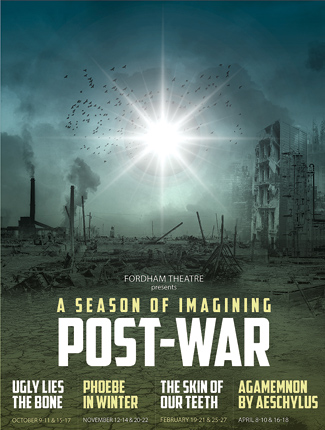 “I don’t think that fish understand that they swim in water. It’s just their reality.”
“I don’t think that fish understand that they swim in water. It’s just their reality.”
The same is true for Americans who don’t realize they’ve lived their lives in a state of perpetual war, said Matthew Maguire, director of the Fordham Theatre Program.
This season, Fordham Theatre’s mainstage season tackles a concept that is radical, given the fact that the United States has been in armed conflict for most of its 238-year existence: What happens when war ends.
“There was a brief window when we were out of Iraq and it looked like we were going to be getting out of Afghanistan by the end of 2014,” Maguire said. “If that had happened, we might have no longer been at war.
“I was staggered by the possibility. In talking with students last year, I asked them, ‘It seems like we’ve been in a perpetual state of war. Can we even imagine what it would be like if we weren’t?’”
The season kicks off on Oct. 9 with Ugly Lies the Bone by Lindsey Ferrentino. The play, which is also running Oct. 15-17, is a contemporary story about a veteran who returns to her home in Florida with burns over 80 percent of her body.
It will be followed in November by Phoebe In Winter by Jen Silverman, Thornton Wilder’s Skin of Our Teeth in February, and the classic Greek tragedy Agamemnon, by Aeschylus, to close out the season in April.
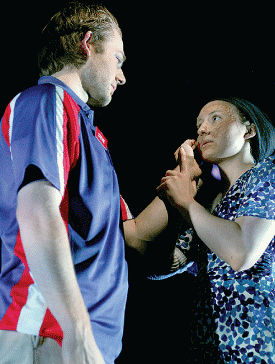
The plays are presented backwards chronologically. Jenny Slattery, associate director of Fordham theatre, noted that even factoring for the gulf of time (Agamemnon was written in the fifth century B.C.), the same questions about war, family, and identity arise over and over.
“The question of home and whether you can come home is such a multifaceted question,” she said.
“There’s the journey itself—can you just get home at all? But then there’s the question, what is home? When you get there, have you actually arrived? Is it still home if the town has changed? If the people are gone? Is it still home if you’ve changed?”
Maguire said the plays aren’t anti-war in a traditional sense; rather, they illustrate the complex struggles that even victors face when they leave the battlefield.
Slattery is concerned with the way that modern-day war permeates life far from the battlefield, via mediums like Youtube and Twitter. Add to that the fact that today’s Fordham freshmen were in kindergarten during the 9/11 attacks, and you have a generation that—like the fish in water—has never known a time when the nation hasn’t been at war.
“It’s hard to imagine ‘post-war’ when you’ve lost your ability to even define and contain war. If we don’t know where war starts and stops, it’s hard to know what’s beyond it,” she said.
Mainstage performances are at 8 p.m. at Pope Auditorium. For more information, call (212) 636-6340 or visit http://www.fordham.edu/theatre/.
Founded in 1841, Fordham is the Jesuit University of New York, offering exceptional education distinguished by the Jesuit tradition to more than 15,100 students in its four undergraduate colleges and its six graduate and professional schools. It has residential campuses in the Bronx and Manhattan, a campus in West Harrison, N.Y., the Louis Calder Center Biological Field Station in Armonk, N.Y., and the London Centre in the United Kingdom.
]]>